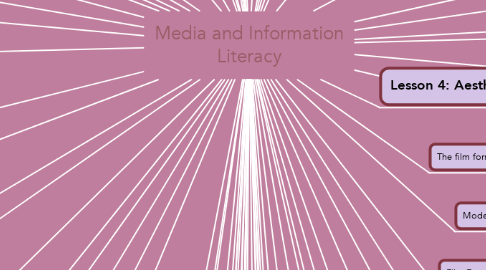Media and Information Literacy
by lei Andrea Pañares

1. Entertainment portals
2. Advocacy campaigns for social change
3. Social services and governance
4. business and customer care tools
5. Personal communications
6. Relevance of social media in today’s society
7. Social networking sites
8. Video-based
9. Phtoto-based
10. Print based
11. Audio-based
12. Kinds of social media and its varying uses
13. What is social media networking
14. Deeper understanding of socialmedia
15. Transitioning media, transitioning users
16. Film + Internet = youtube
17. Broadcasting + Internet = Podcast
18. Journalism + Internet = blogging
19. Intersecting traditional media and new media
20. New media transitions: from synergy to transmedia
21. New media as multimedia
22. Deconstructing new media
23. New Media technology: converge and characteristics
24. State-owned media
25. Alternative and independent media
26. community media
27. Media ownership
28. Mainstream media
29. the local landscape
30. The broadcast industry
31. From globalization to glocalization
32. Local online media
33. The state of media today
34. The european film import
35. The print industry and filipino freedom
36. Pre-colonial traces
37. Brief History of philippine media
38. Digital Age
39. Electronic Age
40. Industrial age
41. Pre-industrial age
42. Brief History of media
43. lesson 2 : Media Then and now
44. Lesson 5 : Aesthetics of new media
45. Lesson 6: Aesthetics of social networking
46. Traditional media
47. Educational tools
48. Informative programming
49. Creating meaning in audiovisual product
50. Creating meaning in image production
51. Creating meaning in audio production
52. Crafting media messages
53. Tv show anatomy and advertising
54. Entertainment programming
55. Kinds of tv shows
56. The tv broadcast
57. Motion framing concepts
58. Film image composition
59. Experimental
60. Animation
61. Documentary
62. Narrative
63. Film Format
64. Modes of film production
65. The film form
66. Radio and evoking imagination
67. Framing and listening
68. Photography and timeless image concepts
69. Books, comics, magazines and the publising industry
70. Newspapers and journalism
71. Framing and reading
72. 1.1.5 Kinds of Media
72.1. Traditional Media
72.2. New Media
72.3. Social media
72.4. Mobile Communication Technology
72.5. Related and Emerging Technologies
73. 1.1.1 The communication process
74. 1.1 Defining Media
75. 1.1.4 Media as a culture of Entertainment
76. 1.1.3 Media as an information industry
77. 1.1.2 The feedback mechanism
78. Lesson 3 : Aesthetics of the image,text and audio
79. Lesson 4: Aesthetic of film and tv


